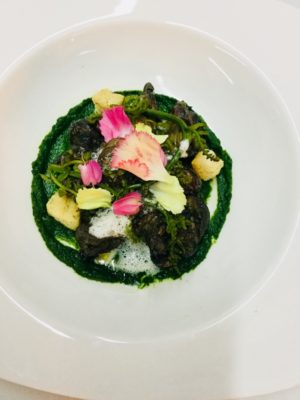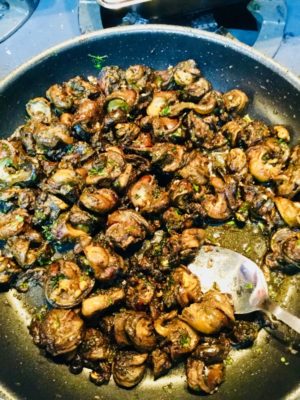
Takyong with arugula coulis and arugula-
infused emulsion.
IT TOOK me almost a year to get acquainted with takyong, or bush snails (Helicostyla daphinis), our own poor man’s
version of the French delicacy, escargot (Helix pomatia).
I first heard about takyong during a day tour to a few southern towns on this island where a busload of Cebu-based chefs were introduced to local producers and farmers (and in Argao, we were given a demo on how to make Jessie’s homemade
torta).
My friend, Boboi Costas, who works at the Capitol and organized the tour, mentioned about this local species of snail that is abundant in Borbon, and how they are trying to promote this delicacy.
I recently have acquired a taste for local wild ingredients like bato pingol, gotu kola, or sinaw-sinaw, and I have been in search of local, wild ingredients with names as exotic as tugis, or the herb, hambuboy, that are hardly used in most culinary kitchens in the metro.
When I got home from the trip, I searched the internet for whatever I could learn about takyong.
These snails, which are mostly found in Barangay Managase in Borbon are considered by locals to be clean snails, as they feed mainly on algae, dew and sap of bushes (coffee bushes) and trees like labnog and jackfruit where they live.
Then I remembered my friend, Bernadette, who hails from Borbon, and I asked her about takyong and how to get them. She was quick to volunteer that she could ask a relative to get takyong for me.
The only problem was how to get them to the city, and I found not a chance to drive up north just to pick them up. .
After several attempts of trying to get hold of my takyong, I then realized that my tailor, who now lives in Borbon, could actually source them for me.

After boiling the snails in coconut milk, the writer sautées the flesh of the snails in brown butter before adding the parsley, garlic and shallots.
So, last Friday, my takyong arrived — at long last! One casserole of live, beautifully helix-shelled gastropods.
I have never tasted or eaten any snail of this kind, except for once when I had escargot at Tymad, a couple of years ago. (The flavors of that dish have remained etched in my memory.)
But Filipinos who cook snails (like kuhol), usually use gata, with lots of ginger, some fish sauce and even, bagoong.
In Borbon, according to my atelier’s new security guard (who also happens to come from Borbon), they cook it adobo or humba style.
Others use takyong for sisig, or as “subak” to their mixed vegetable dish, in lieu of pork (especially during lean times in the mountain villages).
But for my own takyong dish, I am taking inspiration from how takyong lives and what it feeds on, and thus pairing it with some greens like arugula or spinach will make it a light and fresher starter dish.
Takyong is boiled in coconut or fresh milk before it is sautéed with shallots, garlic, and either with parsley or sangig (native basil).
In this first attempt to cook takyong, I am using arugula, primarily because of its slight pungent, peppery and nutty flavors, which
I am thinking will balance well with the earthy taste of the takyong.
To give it a modern edge, arugula is done two ways: the greens are made into a coulis, and the stalks an emulsion that goes through the hand blender to create foam for better mouth feel.
I serve my takyong dish with garlic crisps, pako greens (Diplazium esculentum), croutons, and edible flowers.
I have committed myself to doing more takyong dishes in the coming weeks, using different flavor combinations and methods, and I will surely share here in this column whatever I can come up with.
